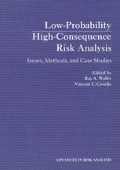Abstract
Three feasible ways of performing a Human Reliability analysis are compared in terms of their goals, assumptions, methodology, advantages, disadvantages, and the extent to which each method has been validated. Theoretical and pragmatic criticisms of HR are examined and answered.
Access this chapter
Tax calculation will be finalised at checkout
Purchases are for personal use only
Preview
Unable to display preview. Download preview PDF.
References
A. D. Swain and H. R. Guttmann, Handbook of Human Reliability Analysis with Emphasis on Nuclear Power Plant Applications, NUREG/CR-1278, U.S. Nuclear Regulatory Commission (October 1980).
B. J. Bell, Human reliability analysis: a case study, Proceedings, Workshop on Low-Probability/High-Consequence Risk Analysis (1983).
D. Meister, Comparative Analysis of Human Reliability Models, L0074-1U7, Bunker-Ramo Corporation, Westlake Village, California (November 1971).
D. Meister, A critical review of human performance reliability predictive methods, IEEE Transactions on Reliability, R-22(3), 116–123 (1973).
S. J. Munger, R. W. Smith, and D. Payne, An Index of Electronic Equipment Operability: Data Store, AIR-C43-1/62-RP(1), American Institute for Research, Pittsburgh, Pennsylvania (January 1962).
A. I. Siegel and J. J. Wolf, Man-Machine Simulation Models: Performance and Psychological Interactions, Wiley, New York (1969).
U.S. Department of the Navy, Human Reliability Prediction System User’s Manual, Sea Systems Command, Washington, D.C. (December 1977).
R. W. Pew, S. Baron, C. E. Feehrer, and D. C. Miller, Critical Review and Analysis of Performance Models Applicable to Man-Machine Systems Evaluation, AFOSR TR-77-0520, Bolt, Beranek and Newman, Cambridge, Massachusetts (March 1977).
D. E. Embrey, Human Reliability in Complex Systems: An Overview, NCSR.R10, National Center of System Reliability, Warrington, England (July 1976).
D. Meister, Human Reliability, In: Human Factors Review (F. A. Muckler, ed.), Human Factor Society, Santa Monica, California (1983).
U.S. Air Force, Human Engineering Design Criteria for Aerospace Systems and Equipment, Part I. Aerospace System Ground Equipment, Military Standard 803A-1 (January 1964).
A. I. Siegel and P. J. Cosentino, Application and Validation of a Model for Crew Simulation, Applied Psychological Services, Wayne, Pennsylvania (1971).
A. I. Siegel and P. J. Federman, Prediction of Human Reliability. Part I: Development and Test of a Human Reliability Predictive Technique for Application in Electronic Maintainability, Contract N63369-71-C-0014, Naval Air Development Center, Warminster, Pennsylvania (1971).
A. I. Siegel and W. Miehle, Extension of a Prior Personnel Subsystem Reliability Determination Technique, Applied Psychological Services, Wayne, Pennsylvania (1967).
A. I. Siegel and W. Miehle, Maintenance Personnel Subsystem Reliability Prediction for the Hindsight System, Applied Psychological Services, Wayne, Pennsylvania (1967).
A. I. Siegel, J. J. Wolf, and M. R. Lautman, A Model for Predicting Integrated Man-Machine System Reliability, Applied Psychological Services, Wayne, Pennsylvania (1974).
A. I. Siegel, J. J. Wolf, and M. R. Lautman, A family of models for measuring human reliability, Proceedings, 1975 Reliability and Maintainability Symposium, Washington, D.C., 110-115 (1975).
D. Meister, Criteria for development of a human reliability methodology, in: Proceedings of the U.S. Navy Human Reliability Workshop, July 22–23, 1970 (J. P. Jenkins, ed.), NAVSHIPS 0967-412-4010, Naval Ship Systems Command, Washington, D.C. (February 1971).
W. B. Askren and T. L. Regulinski, Mathematical Modeling of Human Performance Errors for Reliability Analysis of Systems, AMRL-TR-68-93, Aerospace Medical Research Laboratories, Wright-Patterson AFB, Ohio (January 1969).
W. B. Askren and T. L. Regulinski, Quantifying Human Performance Reliability, AFHRL-TE-71-22, Air Force Human Resources Laboratory, Brooks AFB, Texas (June 1971).
D. Hebb, Drives and the C. N. S. (Conceptual Nervous System), Psychological Review, 62, 243–254 (1955).
I. A. Irwin, J. J. Levitz, and A. M. Freed, Human Reliability in the Performance of Maintenance, LRP 317/TDR-63-218, Aerojet General Corporation, Sacramento, California (May 1964).
R. A. Goldbeck and J. D. Charlet, Task Parameters for Predicting Panel Layout Design and Operator Performance, WDL-TR-5480, Philco-Ford Corporation, Palo Alto, California (June 1974).
R. A. Goldbeck and J. D. Charlet, Prediction of Operator Work Station Performance, WDL-TR-7071, Aeroneutronic Ford Corporation, Palo Alto, California (November 1975).
A. D. Swain, A note on the accuracy of predictions using THERP, Human Factors Bulletin, 25, 4, 1–2 (April 1982).
T. L. Regulinski, Quantification of human performance reliability research method rationale, In: Proceedings of U.S. Navy Human Reliability Workshop, July 22–23, 1970 (J. P. Jenkins, ed.), Washington, D.C., NAVSHIPS 0967-412-4010, Naval Ship Systems Command, Washington, D.C. (February 1971).
J. A. Adams, Issues in human reliability, Human Factors, 24, 1–10 (1982).
D. E. Embrey, A new approach to the evaluation and quantification of human reliability in systems assessment, Proceedings, Third National Reliability Conference-Reliability 81, Birmingham, England, 5B/1/1-5B/1/12 (1981).
D. E. Embrey, The Use of Performance Shaping Factors and Quantified Expert Judgment in the Evaluation of Human Reliability: An Initial Appraisal, HR-BNL-2, Brookhaven National Laboratory, Upton, New York (September 1981).
Author information
Authors and Affiliations
Editor information
Editors and Affiliations
Rights and permissions
Copyright information
© 1984 Springer Science+Business Media New York
About this chapter
Cite this chapter
Meister, D. (1984). Alternate Approaches to Human Reliability Analysis. In: Waller, R.A., Covello, V.T. (eds) Low-Probability High-Consequence Risk Analysis. Advances in Risk Analysis, vol 2. Springer, Boston, MA. https://doi.org/10.1007/978-1-4757-1818-8_20
Download citation
DOI: https://doi.org/10.1007/978-1-4757-1818-8_20
Publisher Name: Springer, Boston, MA
Print ISBN: 978-1-4757-1820-1
Online ISBN: 978-1-4757-1818-8
eBook Packages: Springer Book Archive

